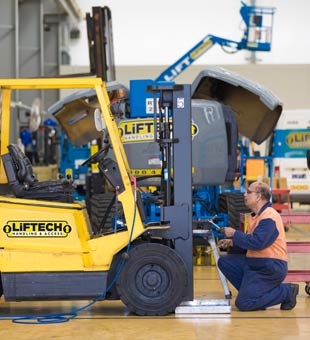Forklift Inspection Checklist: Did You Inspect Your Forklift?
If you own a forklift or two, did you know that Occupational Health & Safety requires them to be inspected before use? When operating a forklift, you’re taking responsibility for a machine that has the potential to cause accidents, injury or even death if it’s not maintained correctly and kept in serviceable condition. Ensuring that you’ve inspected your machine is essential.

What should I look at in a visual pre-start check?
- The general condition and cleanliness of the forklift;
- That the floor is clear of objects that could cause an accident;
- That the overhead is clear of obstructions that could interfere with safe forklift usage;
- Any nearby objects to avoid as you drive away;
- That a fire extinguisher is present and charged;
- That the engine oil level, fuel level and radiator water level are all within the correct ranges;
- That the battery is fully charged and secured in place;
- That the wheels and tires are in good condition;
- That any bolts, nuts, guards, chains or hydraulic hose reels aren’t damaged, missing or loose;
- That the chain and anchor pins aren’t worn, loose or bent;
- That there are no damp spots or drips, which could suggest a fluid leak;
- That the horn is working and loud enough to be heard in the working environment;
- That the seatbelt or operator restraint device functions properly; and
- That a load rating plate is fitted to the machine and that it’s clearly legible.
What should I look at in an operational pre-start check?
- That the foot brake is functioning and the forklift stops smoothly;
- That the parking brake is in good working order (it should hold against slight acceleration);
- That the lift mechanism operates smoothly;
- That the tilt mechanism operates smoothly and holds (check this by tilting the mast all the way forward and backward);
- That the seat brake holds when the operator stands (if fitted);
- That all lights and gauges on the dash control panel are operational (and that no warning lights are on);
- That the gearshift and clutch shift smoothly without jumping or jerking;
- That the cylinders and hoses aren’t leaking (do this last, after performing all other checks);
- That the reversing alarm is in good operation;
- That the strobe lamp flashes when the key is turned to the "on" position in the forklift’s ignition;
- That the steering wheel moves smoothly; and
- Listen for any unusual sounds or noises whilst the forklift is running.
We hope that the information provided above has enabled you to more easily perform forklift inspections. It is essential that these checks are performed before using the machine, each and every day. The forklift might have been in excellent condition yesterday, but something could have happened between now and then that has made it unsafe for use.